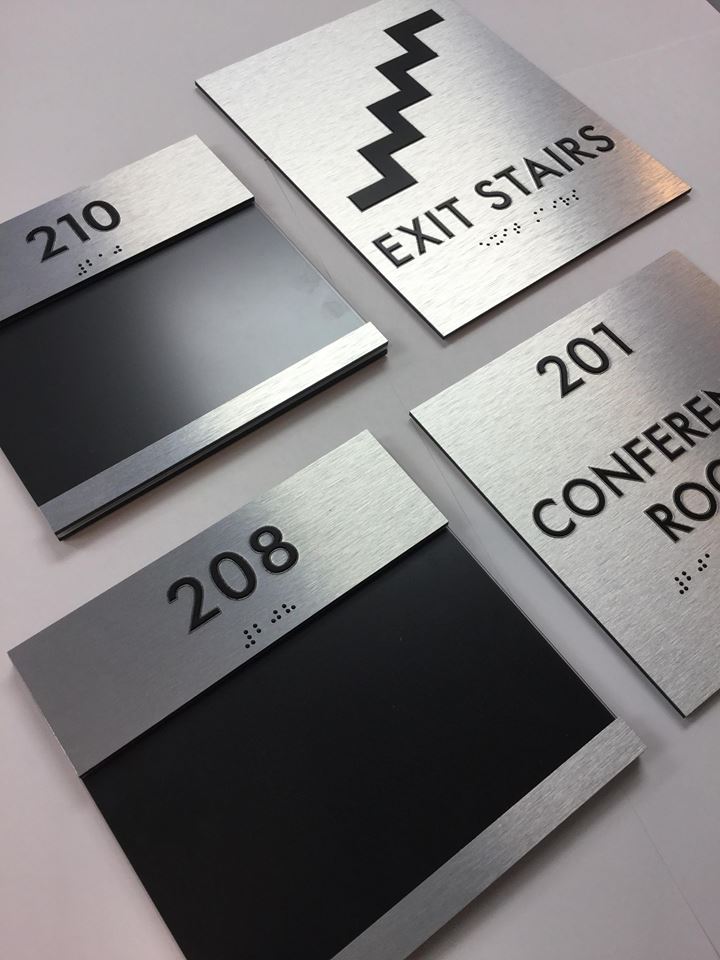The Advantages of Using Premium ADA Signs in Your Service
Discovering the Trick Functions of ADA Indications for Improved Ease Of Access
In the realm of accessibility, ADA signs act as quiet yet powerful allies, guaranteeing that spaces are comprehensive and navigable for individuals with disabilities. By integrating Braille and tactile elements, these indicators break obstacles for the visually impaired, while high-contrast color pattern and readable fonts satisfy varied visual needs. Moreover, their critical positioning is not arbitrary yet rather a calculated initiative to help with smooth navigating. Past these functions exists a deeper story about the advancement of inclusivity and the continuous dedication to creating fair spaces. What extra could these signs indicate in our quest of global availability?
Significance of ADA Compliance
Making certain conformity with the Americans with Disabilities Act (ADA) is critical for fostering inclusivity and equivalent accessibility in public spaces and work environments. The ADA, established in 1990, mandates that all public centers, employers, and transportation services fit people with disabilities, ensuring they delight in the very same civil liberties and opportunities as others. Compliance with ADA criteria not only fulfills legal responsibilities however additionally boosts a company's reputation by demonstrating its commitment to diversity and inclusivity.
One of the essential elements of ADA compliance is the application of easily accessible signs. ADA indications are made to ensure that people with handicaps can conveniently browse via structures and rooms. These indications need to stick to details standards pertaining to dimension, typeface, shade contrast, and placement to guarantee visibility and readability for all. Properly implemented ADA signs aids remove obstacles that individuals with impairments commonly run into, therefore advertising their freedom and self-confidence (ADA Signs).
In addition, adhering to ADA laws can alleviate the danger of legal effects and prospective penalties. Organizations that fall short to conform with ADA standards might face fines or claims, which can be both destructive and financially challenging to their public picture. Hence, ADA compliance is indispensable to fostering a fair environment for everybody.
Braille and Tactile Elements
The incorporation of Braille and tactile components into ADA signs embodies the principles of ease of access and inclusivity. It is commonly placed below the matching message on signs to make certain that people can access the details without visual assistance.
Responsive elements extend past Braille and consist of increased symbols and characters. These components are made to be noticeable by touch, enabling individuals to identify room numbers, restrooms, leaves, and various other important locations. The ADA sets specific standards pertaining to the dimension, spacing, and placement of these responsive components to enhance readability and guarantee consistency across different environments.

High-Contrast Shade Plans
High-contrast color pattern play a critical function in enhancing the exposure and readability of ADA signage for people with visual problems. These plans are important as they take full advantage of the distinction in light reflectance between message and background, making certain that indications are conveniently discernible, also from a distance. The Americans with Disabilities Act (ADA) mandates using particular shade contrasts to accommodate those with minimal vision, making it an important facet of compliance.
The efficiency of high-contrast colors hinges on their capacity to stand apart in numerous lighting conditions, consisting of dimly lit atmospheres and locations with glare. Normally, dark text on a light background or light message on a dark history is employed to attain ideal comparison. Black message on a yellow or white background offers click here for info a raw aesthetic difference that aids in quick acknowledgment and understanding.

Legible Fonts and Text Size
When taking into consideration the layout of ADA signs, the option of readable font styles and suitable text size can not be overemphasized. The Americans with Disabilities Act (ADA) mandates that typefaces need to be not italic and sans-serif, oblique, script, highly decorative, or of uncommon type.
The dimension of the text also plays a pivotal duty in access. According to ADA standards, the minimal text height need to be 5/8 inch, and it needs to boost proportionally with seeing distance. This is particularly vital in public spaces where signage demands to be reviewed quickly and properly. Uniformity in text dimension contributes to a natural visual experience, aiding look at this now people in navigating settings effectively.
Moreover, spacing in between letters and lines is integral to readability. Appropriate spacing prevents personalities from showing up crowded, enhancing readability. By sticking to these standards, developers can considerably boost ease of access, making certain that signage offers its intended function for all people, despite their visual capacities.
Effective Positioning Strategies
Strategic placement of ADA signage is essential for maximizing access and making certain compliance with legal requirements. Properly positioned indications direct individuals with specials needs properly, helping with navigation in public areas. Secret considerations include presence, elevation, and closeness. ADA standards specify that indicators need to be mounted at a height in between 48 to view it 60 inches from the ground to guarantee they are within the line of view for both standing and seated people. This standard height array is essential for inclusivity, allowing mobility device users and individuals of differing elevations to accessibility information effortlessly.
Furthermore, signs have to be put surrounding to the latch side of doors to permit simple recognition before entry. Consistency in sign placement throughout a center improves predictability, lowering confusion and boosting general customer experience.

Verdict
ADA indications play a crucial function in promoting availability by incorporating attributes that attend to the demands of individuals with impairments. These aspects collectively foster a comprehensive setting, highlighting the value of ADA compliance in ensuring equal access for all.
In the realm of access, ADA indicators offer as silent yet effective allies, making certain that areas are navigable and inclusive for individuals with handicaps. The ADA, established in 1990, mandates that all public facilities, employers, and transport services accommodate people with impairments, guaranteeing they take pleasure in the exact same legal rights and possibilities as others. ADA Signs. ADA indicators are created to make certain that individuals with impairments can conveniently navigate through structures and spaces. ADA guidelines state that signs need to be installed at an elevation between 48 to 60 inches from the ground to guarantee they are within the line of sight for both standing and seated people.ADA indications play a vital function in promoting availability by integrating features that attend to the needs of people with disabilities